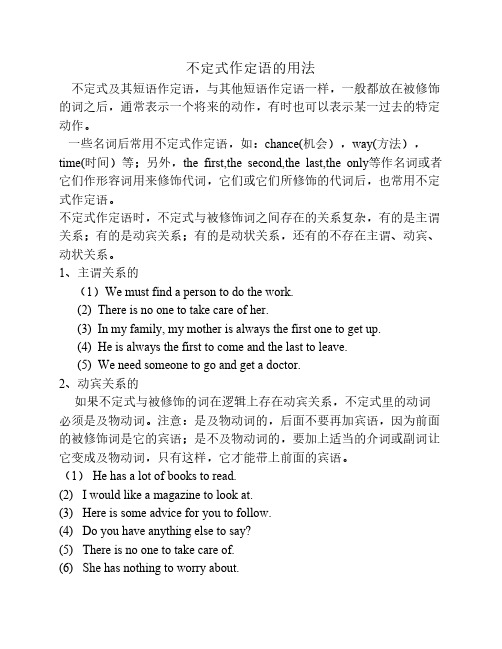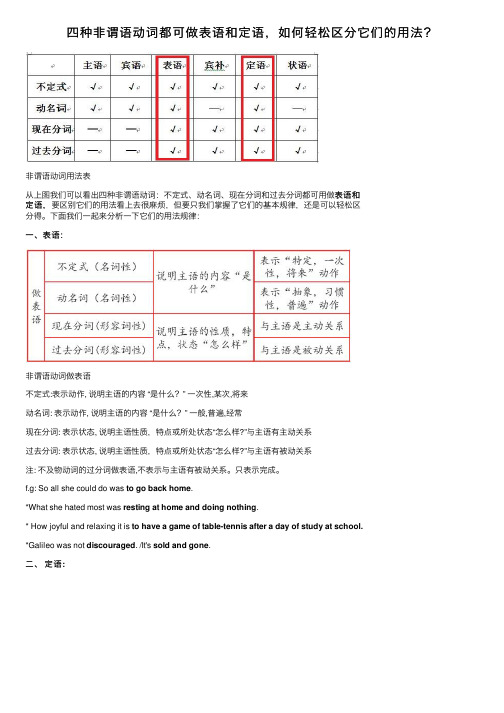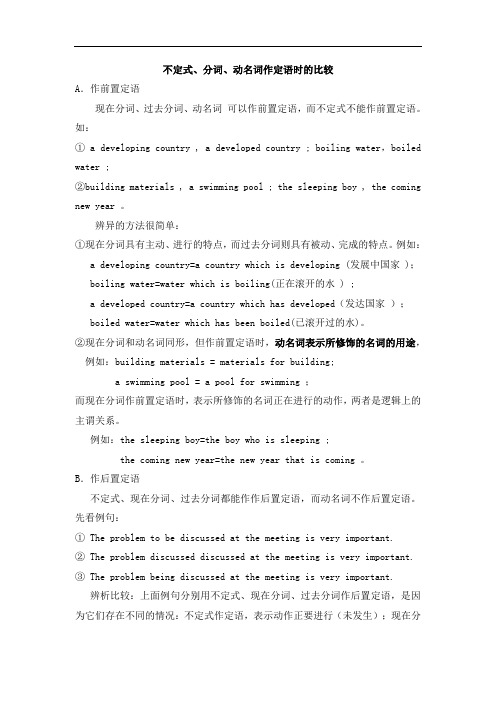动名词、动词不定式、分词作定语区别.
不定式、动名词、过去分词 作定语的用法

不定式作定语的用法不定式及其短语作定语,与其他短语作定语一样,一般都放在被修饰的词之后,通常表示一个将来的动作,有时也可以表示某一过去的特定动作。
一些名词后常用不定式作定语,如:chance(机会),way(方法),time(时间)等;另外,the first,the second,the last,the only等作名词或者它们作形容词用来修饰代词,它们或它们所修饰的代词后,也常用不定式作定语。
不定式作定语时,不定式与被修饰词之间存在的关系复杂,有的是主谓关系;有的是动宾关系;有的是动状关系,还有的不存在主谓、动宾、动状关系。
1、主谓关系的(1)We must find a person to do the work.(2) There is no one to take care of her.(3) In my family, my mother is always the first one to get up.(4) He is always the first to come and the last to leave.(5) We need someone to go and get a doctor.2、动宾关系的如果不定式与被修饰的词在逻辑上存在动宾关系,不定式里的动词必须是及物动词。
注意:是及物动词的,后面不要再加宾语,因为前面的被修饰词是它的宾语;是不及物动词的,要加上适当的介词或副词让它变成及物动词,只有这样,它才能带上前面的宾语。
(1) He has a lot of books to read.(2) I would like a magazine to look at.(3) Here is some advice for you to follow.(4) Do you have anything else to say?(5) There is no one to take care of.(6) She has nothing to worry about.3、动状关系的被修饰词如果是不定式里动词的状语,应多用介词短语。
不定式,动名词,分词

表语 Don’t touch the glass because it is broken. 定语 The excited people rushed into the building. 状语 Seen from the top of the hill, the city looked like a big garden. 补足语 When you are making a speech, you should speak louder to make yourself heard.
9. 分词 9.1 分词作定语
分词前置 如: We can see the rising sun. 我们可以看到东升的旭日 He is a retired worker. 他是位退休的工人 分词后置 (i分词词组;ii 个别分词如given, left; iii 修饰不定代词 something等) 如: There was a girl sitting there. 有个女孩坐在那里 This is the question given. 这是所给的问题 There is nothing interesting. 没有有趣的东西
过去分词作定语 与其修饰的词是被动关系,相当 于一个被动语态的定语从句。 如: Most of the people invited to the party were famous scientists.
典型例题
1) The first textbook ___ for teaching English as a D foreign language came out in the 16th century. A. have written B. to be written C. being written D. written 答案D. 书与写作是被动关系,应用过去分词做定 语表被动,相当于定语从句 which is written
不定式、分词、动名词差别

高中英语:不定式、分词、动名词1. 动名词与不定式的区别动名词起名词作用,在句子中可以作主语、宾语、表语、定语、主语补足语、宾语补足语。
不定式起名词、形容词、副词作用,在句子中除了动名词所起的作用外,还可以作状语。
但两者之间也有差别:(1)不定式的逻辑主语必须与主语一致,而动名词的逻辑主语范围较大,它可以指主语,也可以是泛指。
如:I hate to work on weekends . 我讨厌周末干活。
(指自己干活)。
I hate working on weekends . 我讨厌周末干活。
(可以指自己,也可以泛指)(2)动名词多指抽象的、概念性的动作,可以是多次的、经常的行为,不定式多表示具体的动作,尤其是某一次的动作。
如:Reading in bed is a pleasure .I like swimming but I don’t like to swim in the pool today .我喜欢游泳,但是今天我不喜欢在游泳池里游泳。
Talking for hours at a stretch is more exhausting than you seem to think .一连讲几个小时的话会比你想像的似乎要累。
(泛指讲话)To talk for hours at a stretch is more exhausting than you seem to think .一连讲几个小时的话可比你想像的似乎要累。
(指个人的感受)(3)在某些动词之后只能用动名词,而另一些动词之后只能用不定式。
后接动名词的动词有:admit,avoid,consider,defer,delay,deny,dislike,enjoy,escape,fancy,finish,imagine,include,keep,mind,miss,postpone,practise,recall,recollect,resent,resist,risk,stop,suggest等;短语动词有have done,give up等。
不定式、动名词、过去分词作定语的用法

不定式作定语的用法不定式及其短语作定语,与其他短语作定语一样,一般都放在被修饰的词之后,通常表示一个将来的动作,有时也可以表示某一过去的特定动作。
一些名词后常用不定式作定语,如:chance(机会),way(方法),time(时间)等;另外,the first,the second,the last,the only等作名词或者它们作形容词用来修饰代词,它们或它们所修饰的代词后,也常用不定式作定语。
不定式作定语时,不定式与被修饰词之间存在的关系复杂,有的是主谓关系;有的是动宾关系;有的是动状关系,还有的不存在主谓、动宾、动状关系。
1、主谓关系的(1)We must find a person to do the work.(2) There is no one to take care of her.(3) In my family, my mother is always the first one to get up.(4) He is always the first to come and the last to leave.(5) We need someone to go and get a doctor.2、动宾关系的如果不定式与被修饰的词在逻辑上存在动宾关系,不定式里的动词必须是及物动词。
注意:是及物动词的,后面不要再加宾语,因为前面的被修饰词是它的宾语;是不及物动词的,要加上适当的介词或副词让它变成及物动词,只有这样,它才能带上前面的宾语。
(1)He has a lot of books to read.(2) I would like a magazine to look at.(3) Here is some advice for you to follow. (4) Do you have anything else to say?(5) There is no one to take care of.(6) She has nothing to worry about.3、动状关系的被修饰词如果是不定式里动词的状语,应多用介词短语。
分词,动名词,不定式三者的用法有什么区别

以下是我的解答,虽然有点啰嗦,希望你能喜欢,也希望你的英语越学越好。
谢谢英语中,非限定动词也叫非谓语动词,也就是不定式、分词和动名词。
顾名思义,不定式、分词和动名词在英语句子中是不能做作谓语的。
非谓语动词虽然不能在句子中作谓语,但由于它们本身具有动词的一些特征,它们在句子中的运用是非常活跃的。
他们之间的用法既有共同点,又有一定的区别,是历年高考必考的语法项目,例如NMET2005年单项填空题(全国卷)中就有这样一题:32,The storm left, ________ a lot of damage to this area.A. causedB. to have causedC. to causedD. having caused根据题意,本题应选D------分词作状语,表示结果。
如何正确地运用好非谓语动词,是许多学生普遍感到棘手的问题,本文将就不定式、分词和动名词的词性特征和句法功能等方面进行比较,帮助学生正确地运用好非谓语动词。
一、基本形式a.不定式的基本形式是“小品词to﹢动词原形” 即to﹢v. ;但有时也可省去to, 即:(to) ﹢v.。
b.分词有两种基本形式:现在分词(the present participle)和过去分词(the past participle)。
①现在分词的基本形式是动词的—ing形式,如,writing, doing ,working ,going, etc.②过去分词的基本形式是:a) 规则动词﹢ed, 即v.-ed, 如,visit→visited ,ask→asked ,dig→digged ,etc; b) 不规则动词有其自身的过去式和过去分词,学生需要用心熟记,方能正确使用。
如,go→went→gone; do→did→done, etc .c.动名词的基本形式与现在分词的基本形式相同,都是动词的—ing 形式,如,doing ,wr iting ,doing ,etc .二、时态、语态及其基本用法A. 不定式1.不定式的时态、语态有三种形式:①一般式,如,to write / to be written ;②进行式,如,to be writing / to have been writing;③完成式,如,to have written / to have been w ritten 。
不定式,动名词和分词的区别

不定式和动名词作主语区别1.含义上的不同。
不定式一般表示特定的,具体的行为,特别是表示将来的,或一次性的行为。
如:To write a new book about medicine is his wish. 写一部医学方面的新书是他的愿望。
(将来的动作) It took me two hours to finish this work today. (表示一次性的动作)动名词表示一般的事实Raising pigs is her job. 养猪是她的工作。
2. 结构上的不同。
在一些固定的句子中动名词It’s no use doing It is useless doing 做……无用It’s no good doing It’s no help doing 做……无用,无益There be 句型 There is no joking about such matter.不定式It isn’t easy to do I have no time to do不定式复合结构 It is + adj.+ of/for sb + to do It is very kind of you to help me.代词+不定式结构 Mary’s coming late made him angry.疑问词+不定式 Where to hold the meeting has not been decided.It’s time for sb to do3. 主语和表语同时使用要一致To live is to learn.Reading is learning.不定式、动名词和分词作表语区别1.动名词和不定式相当于一个名词,分词相当于一个形容词。
2.不定式、动名词与分词作表语的区别。
不定式和动名词作表语相当于一个名词作表语,含义是回答主语“是什么”;分词作表语相当于形容词作表语,含义是回答主语“怎么样”。
如:① Our plan is to keep the affair secret. 我们的计划是让这件事成为秘密。
怎么找非谓语动词讲解

怎么找非谓语动词讲解非谓语动词是指动词的非谓语形式,不受动词的时态和人称的限制,通常用来作状语、定语和补语。
下面是关于非谓语动词的讲解和相关参考内容。
一、非谓语动词的种类及形式:非谓语动词包括动名词、不定式和分词三种形式。
1. 动名词:动名词的构成是动词原形+ing。
它可以作主语、宾语、定语、状语和补语等。
例如:- Smoking is harmful to your health. (作主语)- I enjoy swimming in the sea. (作宾语)- Do you mind me using your computer? (作定语)- He left home without saying goodbye. (作状语)- His dream is becoming a pilot. (作补语)2. 不定式:不定式的构成是“to + 动词原形”。
它可以作主语、宾语、定语、状语和补语等。
例如:- To travel around the world is my dream. (作主语)- She wants to be a doctor when she grows up. (作宾语)- I have a lot of books to read. (作定语)- He studied hard to pass the exam. (作状语)- His wish is to become a famous singer. (作补语)3. 分词:分词分为现在分词和过去分词两种形式。
现在分词的构成是动词原形+ing,过去分词的构成有规律变化和不规律变化两种。
分词可以作定语、状语和补语等。
例如:- The smiling girl is my sister. (作定语)- Walking in the park, he met an old friend. (作状语)- I saw a broken window in the house. (作定语)- She was surprised to see her name on the list. (作补语)二、如何找非谓语动词:1. 看句子结构:非谓语动词通常出现在句子的其他成分之前或之后,根据句子结构找出动名词、不定式或分词的形式。
动词的非谓语形式有三种不定式动名和分词

注①
admit,appreciate,avoid,consider, delay, dislike,enjoy,escape, excuse,face,feel like,finish,forgive,give up, imagine,include,keep,mention,mind,miss,practise,put off,resist, risk,suggest,can’t help,can’t stand(无法忍受)等动词后可以用动名词作宾语,但不能用不定式.
2
动名词的复合结构同由
物主代词
人称代词宾格 +动名词 构成
名词所有格
普通格加
2
2.动名词的复合结构
句子开头必须用名词所有格或物主代词.
例如: His coming made me very happy. Mary’s crying annoyed him. She didn't mind his crying. Is there any hope for Xiao Wang’s winning?
但在 It is no use/ good,not any use/ good,useless /there is no …等后必须用动名词。 例如:
01
02
2)作表语.
例如: Her job is teaching.
He is fond of playing football.
01
I like swimming.
I must remember to do it. (我必须记着做这事.) I tried not to go there. (我没法不去那里. He stopped to talk. (他停下来讲话.) I mean to come early today. (我打算今早些来.)
动名词和分词与动词不定式用法比较

第六讲:动名词和分词与动词不定式用法比较英语中的不定式、动名词和分词(现在分词和过去分词)在句中不能充当谓语,故被称为非谓语动词。
它们都有否定式、被动式和完成式。
否定词not, never总放在它们之前,被动式及完成式见下表:一般式现在式完成式完成进行式其中,动名词还可以被代词及名词所有格修饰,构成动名词的复合结构。
这种代词和名词所有格充当动名词的逻辑主语。
to havebeenkeeping\\\\\to havekeptto havekeepingto keep主动不定式被动to bekeptto havebeingkept\\having kept主动keeping动名词被动being kept主动keeping分词被动being kepthaving beenkepthaving kepthaving beenkept\\\-------His anxiety doesn't justify his being so rude to his mother.他的焦虑不是他对母亲这么粗鲁的理由。
-------The father was angry at his son's spending money like water.父亲对儿子的花钱如流水感到愤怒。
在口语或非正式语体中,也可用宾格代替代词和名词的所有格。
故上面两句可改为:-------His anxiety doesn't justify him being so rude to his mother.-------The father was angry at his son spending money like water.1.作主语(1)动名词和不定式都可充当主语,意义上一般区别不大。
-------Seeing is believing.和To see is to believe.都意为:百闻不如一见。
动名词和分词与动词不定式用法比较

第六讲:动名词和分词与动词不定式用法比较英语中的不定式、动名词和分词(此刻分词和过去分词)在句中不可以充任谓语,故被称为非谓语动词。
它们都有否认式、被动式和达成式。
否认词 not, never 总放在它们以前,被动式及达成式见下表:一般式此刻式达成式达成进行式此中,动名词还能够被代词及名词全部格修饰,组成动名词的复合构造。
这类代词和名词全部格充任动名词的逻辑主语。
to havebeenkeeping\\\\\to havekeptto havekeepingto keep主动不定式被动to bekeptto havebeingkept\\having kept主动keeping 动名词被动being kept 主动keeping 分词被动 being kepthaving beenkepthaving kepthaving beenkept\\\-------His anxiety doesn't justify his being so rude to his mother.他的忧虑不是他对母亲这么鲁莽的原由。
-------The father was angry at his son's spending money like water父.亲对儿子的花费如流水感觉愤慨。
在口语或非正式语体中,也可用宾格取代代词和名词的全部格。
故上边两句可改为:-------His anxiety doesn't justify him being so rude to his mother.-------The father was angry at his son spending money like water.1.作主语(1)动名词和不定式都可充任主语,意义上一般差异不大。
-------Seeing is believing和. To see is to believe都.意为:百闻不如一见。
动词不定式、动名词用法和区别

动词不定式、动名词的用法和区别动词不定式:动词不定式是由to + 动词原形构成,在句中起名词,形容词和副词的作用,可以担任除谓语以外的其它任何成分。
1. 动词不定式作主语:To mast a languag e is not an easy thing. / To teach English is my favorit e.动词不定式作主语时可以放在后面,而用it 作形式主语放在原主语的位置上。
It's very kind of you to have given us much help.2. 动词不定式作宾语:某些及物动词可以用动词不定式作宾语,这些动词有de cide, begin, help, begin, want, wish, like, forget, learn, ask.I like to help othersif I can.3. 动词不定式作宾语补语。
We expectyou to be with us. 我们希望你和我们在一起。
/ Pleaseask him to come here quickly.请叫他快过来。
4. 动词不定式作表语:What I shoulddo is to finishthe task soon. / The most urgentthing is to find the boy immedia tely.5. 动词不定式作定语:There are many ways to solve the problem. / I have somethi ng importa nt to tell you.6. 不定式作状语:We went to the hospita l to see our teacher. / She is makinga test to get a kind of usefulmedicin e from a Tibet flower.动词不定式的否定形式:not + to + 动词原形The teacher told us not to swim in that river. 老师告诉我们不要在那条河里游泳。
英语非谓语动词:不定式,动名词和分词

英语非谓语动词:不定式,动名词和分词非谓语动词分为三种形式:不定式、动名词和分词(包括现在分词和过去分词)(一)动词不定式动词不定式可以作主语、宾语、宾语补足语、定语、状语、表语。
动词不定式由“to+动词原形”构成,否定形式“not to +动词原形”。
1.用法(1)作主语。
往往用it作为形式主语。
如:It is time to get up.(2)作宾语。
如果带有宾语补足语,往往把不定式短语放在宾语补足语之后,用it作形式宾语。
如:I find it interesting to study English.有些动词只能用动词不定式作宾语。
如:decide,plan,desire,hope,wish,promise,ask,agree, manage等。
(3)作宾语补足语A:带to的动词不定式有:ask,tell,want,teach,advise,allow,beg,invite等。
如:He asked me to do the work.B :接不带to的动词不定式有:see,watch,hear,make ,let等。
如:I often see him play football.使役动词不带to,动词有:一感二听三让四观看。
一感:feel 二听:hear, listen to 三让:let,have,make 四观看:observe,see,watch,look at注意:feel, hear,notice, see,watch,have,make等词后的补足语中,不定式不带to,但变成被动结构时,要带to.如:I often hear him cry. He is often heard to cry.注意:带but介词的不定式。
如果介词之前有行为动词do的各种形式,那么but后的不定式不带to,否则要带to。
另外,在can’t choose but...和can’t help but...等后面的不定式也省略to。
四种非谓语动词都可做表语和定语,如何轻松区分它们的用法?

四种⾮谓语动词都可做表语和定语,如何轻松区分它们的⽤法?⾮谓语动词⽤法表表语和从上图我们可以看出四种⾮谓语动词:不定式、动名词、现在分词和过去分词都可⽤做表语和定语,要区别它们的⽤法看上去很⿇烦,但要只我们掌握了它们的基本规律,还是可以轻松区定语,分得。
下⾯我们⼀起来分析⼀下它们的⽤法规律:⼀、表语:⾮谓语动词做表语不定式:表⽰动作, 说明主语的内容 “是什么?” ⼀次性,某次,将来动名词: 表⽰动作, 说明主语的内容 “是什么?” ⼀般,普遍,经常现在分词: 表⽰状态, 说明主语性质,特点或所处状态“怎么样?”与主语有主动关系过去分词: 表⽰状态, 说明主语性质,特点或所处状态“怎么样?”与主语有被动关系注: 不及物动词的过分词做表语,不表⽰与主语有被动关系。
只表⽰完成。
f.g: So all she could do was to go back home.*What she hated most was resting at home and doing nothing.* How joyful and relaxing it is to have a game of table-tennis after a day of study at school.*Galileo was not discouraged. /It's sold and gone.⼆、定语:(1)不定式(后置)a. 与修饰名词主动关系;⽤⼀般主动式(to do),表⽰将来f.g:So he made some candles to give light.b. 与修饰名词被动关系,表⽰将来①与本句中的“主语”是主动关系时,⽤⼀般主动式(to do)f.g:Have you anything to say for yourself?②与本句中的“主语”是不不主动关系时,⽤⼀般被动式:to be donef.g:I’m going to the post office. Have you anything to besent?③不定式为“不及物动词+介词”作定语时,“介词”不可漏掉。
非谓语动词作定语的用法总结

非谓语动词作定语的用法总结
非谓语动词是指不具有主谓结构的动词形式,包括不定式、动名词和分词。
在英语中,非谓语动词也可以用作定语,用来修饰名词或代词。
以下是非谓语动词作定语的用法总结:
1. 不定式作定语:
- 不定式作定语通常放在被修饰的名词之后。
例如:"an easy book to read"(一本容易阅读的书)。
- 不定式作定语可以用来表示目的、用途或结果。
例如:"a tool to fix the bike"(修理自行车的工具)。
2. 动名词作定语:
- 动名词作定语通常放在被修饰的名词之前。
例如:"the swimming pool"(游泳池)。
- 动名词作定语可以用来表示被修饰名词的用途、原因或特征。
例如:"a writing desk"(写字台)。
3. 分词作定语:
- 分词作定语可以是现在分词(-ing形式)或过去分词(-ed形式)。
- 现在分词作定语通常表示正在进行的动作或者被修饰名词的特征。
例如:"a smiling child"(笑着的孩子)。
- 过去分词作定语通常表示被修饰名词的状态或者受到的动作。
例如:"a broken window"(破碎的窗户)。
非谓语动词作定语的用法可以丰富句子,使其更加具体和生动。
熟练掌握这些用法可以帮助我们更好地表达和理解英语。
不定式分词独立主格结构用法之区别

不定式、动名词、分词、独立主格结构用法之区别总述:分词短语作定语时,相当一个定语从句;单个现在分词作定语,常前置;单个过去分词常后置,表一次具体动作;而前置表通常状况。
非谓语的否定式是把not置于非谓语动词前。
分词短语作状语时,相当于各种状语从句,即各种状语从句的主语与主句主语相同,去掉连词和从句主语, 把谓语动词改为非谓语形式;当从句主语与主句主语不同时,则主语不能去掉,即变成独立主格结构, 但不能作定语和补语。
不定式表示(过去或将来)具体某一次动作,强调全过程;或表示将要发生的动作。
不定式表示一般状况与动名词用法相同。
不定式还可做目的状语和结果状语。
单个动名词做主语,谓语用单数;做表语时, 表示主语的性质或具体内容。
一、不定式1、to+动原, 叫做不定式,与动名词、分词一起叫做非谓语形式。
其复合结构也一样;作使役、感观V宾补时,不带to;而当这些动词变成被动语态时要加上to。
省to :(1)help sb / sth (to)动原、don’t dare (to)+动原、prefer to +动原+rather than+(to)动原、do sth but / except (to)+动原, (2)what引导主语从句, everything / all / the bes t 所带定语从句关系代词作do的宾语,则作表语的不定式to可省; (3)and并列多个不定式,第一个以后to可省。
※too + adj / adv+ to动原;adj / adv + enough to +动原;manage / fail to do appeal to sb/sth to do approve of sb/sth to do only to do 不表将要做某事arrange for sb/sth to do demand of sb/sth to do 感观动词+sb/sth do○1I saw her walk across the square and go into a lane. ○2Set a thief to catch a thief.→She was seen to walk across the square and go into a lane.○3She is too young to go to school.○4I often heard him sing in the next room. ○5It’s a pleasure to manaage to get here.○6What / All I want to do is (to) help you with your study. ○7He is old enough to join the army.○8Would you be so kind as to help me with my English study? ○9To see is to believe. or Seeing is believing.○10It’s (of) no use regretting / to regret what has been done. ○11It’s worthwhile writing/to write it all out again. ○12To err is human, to forgive is divine.犯错是凡人,宽恕是圣人.○13Simon had no choice but to work hard then.○14Despite a heavy snow, the children are still looking forward to (not cancel) the outdoor activity at the weekend.○15My job is (water)all the flowers in the garden.○16I’m pleased to see you here. ○17The best that you can do is (manage) the stress in the day to minimize its impact on your health.2、(un)important, dangerous, terrible, (un)fit, surprising, (im)possible, easy, hard/ difficult, light / heavy,nice / beautiful, interesting, pleasant, expensive, weak等作表语时,不定式作条件、结果状语,用主动表示被动, 表明说话人对不定式动作看法或建议。
不定式、分词、动名词作定语时的比较

不定式、分词、动名词作定语时的比较A.作前置定语现在分词、过去分词、动名词可以作前置定语,而不定式不能作前置定语。
如:① a developing country , a developed country ; boiling water,boiled water ;②building materials , a swimming pool ; the sleeping boy , the coming new year 。
辨异的方法很简单:①现在分词具有主动、进行的特点,而过去分词则具有被动、完成的特点。
例如:a developing country=a country which is developing (发展中国家 ); boiling water=water which is boiling(正在滚开的水 ) ;a developed country=a country which has developed(发达国家);boiled water=water which has been boiled(已滚开过的水)。
②现在分词和动名词同形,但作前置定语时,动名词表示所修饰的名词的用途,例如:building materials = materials for building;a swimming pool = a pool for swimming ;而现在分词作前置定语时,表示所修饰的名词正在进行的动作,两者是逻辑上的主谓关系。
例如:the sleeping boy=the boy who is sleeping ;the coming new year=the new year that is coming 。
B.作后置定语不定式、现在分词、过去分词都能作作后置定语,而动名词不作后置定语。
先看例句:① The problem to be discussed at the meeting is very important.② The problem discussed discussed at the meeting is very important.③ The problem being discussed at the meeting is very important.辨析比较:上面例句分别用不定式、现在分词、过去分词作后置定语,是因为它们存在不同的情况:不定式作定语,表示动作正要进行(未发生);现在分词作定语,表示动作正在进行(正在发生);过去分词作定语,表示动作已完成(已发生)。
如何区别三种非谓语动词

我迷路了只好停下来问路。
They stopped talking.
他们停止了谈话。
⑶go on to do sth. (做完一件事之后)接着做(另一件事)
go on doing sth.继续做某事
I don’t wish to be disturbed in my work.
我不愿在工作中被打搅。
We managed to get there in time.
我们设法及时到了那里。
He pretended to be reading a book.
他假装在读书。
你介意把窗户关上吗?
Will you admit having broken the window?
你承不承认打破了窗户了?
He avoided giving us a definite answer.
他避免给我们一个肯定的回答。
I was afraid to let the boy risk climbing the tree.
We began making /to make plans for the work.
我们开始制定工作计划。
I like playing/to play the piano.
我喜欢弹钢琴。
He continued working/ to work as if nothing had happened.
如:
To see is to believe. 百闻不如一见。
=Seeing is believing.
⒉ 一般来讲,在表示比较抽象笼统的一般行为时多用动名词,在表示具体某次动作,特别是将来的动作时,多用不定式。
非谓语动词的翻译

7)can’t help (to) do 表示不能帮助做某事;can’t help doing表示不禁做某事。
8)allow, permit, advise, forbid, consider + doing 或+ sb. to do
9)need, require, want + doing 或+ to be done 表示需要被做某种处理
as to…, so/such… as to… 例1:The doctor held a consultation to decide
whether an operation was necessary. 译文:医生们会诊以决定是否需要动手术。 例2:I come here only to say good-bye to my
1.2非谓语动词作宾语
(1)只能接不定式作宾语的动词,一般有:wish, hope, expect, offer, manage, decide, refuse, agree, pretend, promise, seem, fail, attempt, enable, neglect, afford, demand, long, arrange, destine, learn, appear, help, plan, prepare, etc.
非谓语动词的用法及区别

非谓语动词主要包括不定式、动名词和现在分词。
为了区分这三种不同的非谓语动词的用法和含义,我们将分别从三种非谓语动词在句子中做主语、宾语、宾语补足语、定语、状语、表语以及一些特殊结构句型等角度来区分其用法和细微含义。
1.不定式和动名词作主语的区别(1)动名词作主语通常表示抽象动作;而不定式作主语表示具体动作。
Smoking is prohibited(禁止)here.这里禁止抽烟。
(抽象)It is not very good for you to smoke so much.你抽这么多烟对你身体很不好。
(具体)(2)动名词作主语时,通常用以表示一件已知的事或经验。
不定式短语通常用来表示一件未完成的事或目的。
Climbing mountains is interesting.爬山很有趣。
(经验)Driving a car during the rush hour is tiring.在高峰时刻开车令人厌烦。
(经验)(3)不定式做主语,一般用it当形式主语,把作主语的不定式短语后置。
It took me only five minutes to finish the job.2.不定式、动名词和分词作表语的区别(1)不定式作表语1)不定式作表语一般表示具体动作,特别是表示将来的动作。
To do two things at a time is to do neither.--次做两件事等于未做。
What I would suggest is to start work at once.我的建议是立刻开始干。
2)如果主语是不定式(表示条件),表语也是不定式(表示结果)。
To see is to believe.百闻不如一见。
To work means to earn a living.工作就是为了生活。
3)如果主语是以aim,duty,hope,idea,happiness,job,plan,problem,purpose,thing,wish等为中心的名词,或以what引导的名词性从句,不定式作表语是对主语起补充说明作用。
- 1、下载文档前请自行甄别文档内容的完整性,平台不提供额外的编辑、内容补充、找答案等附加服务。
- 2、"仅部分预览"的文档,不可在线预览部分如存在完整性等问题,可反馈申请退款(可完整预览的文档不适用该条件!)。
- 3、如文档侵犯您的权益,请联系客服反馈,我们会尽快为您处理(人工客服工作时间:9:00-18:30)。
动词的不定式,\分词\.动名词的区别及其用法、搭配。
答:非谓语动词包括动词不定式。
动名词和分词三种形式,分词又包括现在分词和过去分词。
这三种形式都是由动词变来的,但在句子中都不能作谓语,故这三种形式被称为非谓语动词。
下面就这三种形式在用法上的区别浅析如下:
一、动词不定式和动名词在句子中均可作主语和表语
在表示一个具体的。
个别的或将来的动作时,要用动词不定式。
如:
My job is to teach the first-year students grammar.
To study English well is very important.
在表示比较抽象的一般的行为和动作时,二者可以互换。
如:
To climb mountains is a good form of exercise.
Climbing mountains is a good form of exercise.
二、动名词、现在分词和动词不定式都可以作定语
1.动名词作定语时,和它所修饰的名词之间没有逻辑上的主谓关系,只表示被修饰名词的一般用途,必须位于名词之前。
如:
There is a swimming pool in our school.
2.现在分词作定语时,和它所修饰的名词之间有逻辑上的主谓关系,表示所修饰名词的特征。
如:
Listen to the singing bird.
Who is the boy running towards us。
3.动词不定式作定语时,当所修饰的名词指人时,和它所修饰的名词之间有逻辑上的主谓关系。
如:
He is always the first to come to school.
当所修饰的名词指物时,和它所修饰的名词之间有逻辑上的动宾关系。
如:
I have a meeting to attend.
如果作定语的动词不定式中的动词是不及物动词,需加上相应的介词。
如:
I have no room to live in.
There is nothing for me to worry about.
三、动词不定式和分词均可作宾语补足语
动词不定式作宾语补足语时,表示动作已经发生,动作的全过程已经结束。
如:
I heard him knock at the door three times.(=I heard he knocked at the door three times (动作的全过程已经结束)
现在分词作宾语补足语时,表示动作正在进行。
如:
I heard him knocking at the door.(= I heard he was knocking at the door.(动作正在进行)
过去分词也可以作宾语补足语。
如:
I found the glass broken.(= I found the glass was broken.)
注意:动词不定式作宾语补足语时,在动词make,let,have,see,notice,hear,watch, observe,feel,listen to等后面要省略不定式符号to。
如:
I hear him play.
The teacher made him do the exercises again.
help后的动词不定式作宾语补足语时,不定式符号to可加可不加。
如:
He often helps me to study English in his spare time.
当这些动词变为被动语态时,原不定式必须加上to。
如:
He was seen to repair the machine.
四、动词不定式和动名词均可作宾语
1.下列动词后只能跟不定式作宾语: hope, agree, decide, manage, wish, refuse, dare, promise等。
如:
He has promised to lend me the dictionary.
2.下列动词后只能跟动名词作宾语: enjoy, finish, avoid, practise, mind, escape, excuse, suggest, consider(考虑), give up, can't help等。
如:
He wants to give up smoking.
They practise speaking English every day.
3.在动词remember,forget,regret,stop,try等后面跟动词不定式或动名词时,意义上有所差别。
如:
He forgot telling me the news.他忘了曾经告诉过我这个消息。
He forgot to tell me the news.他忘了要把这个消息告诉我。
五、动词不定式和分词均可作状语
不定式作状语通常表示"目的"或"程度";分词作状语通常表示"伴随情况"。
"时间"或"原因"等。
如:
He went to the library to borrow a book (表目的)
The boy sat at the desk reading a book.(表伴随情况)
六、动词不定式和动名词均有复合结构
不定式的复合结构:for sb.(not) to do sth.
动名词的复合结构:名词所有格或形容词性物主代词+动名词。
如:
It's important for us to learn English well.
He prided himself upon his dancing.。
